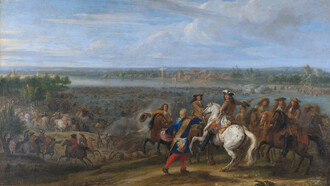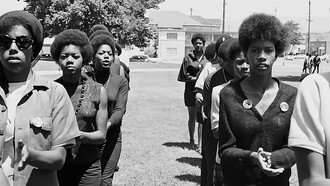This is the fourth of a series of articles on the I Ching, or Yijing, the Book of Changes, an ancient oracle, a divinatory book that played a key role in Chinese culture and became for the Chinese a map of 'heaven and earth', of the totality of existence. Much of this material is contained in the Introduction to the Eranos Yijing1. To that book the reader is referred for a deeper discussion of the concepts here presented.
Origins of the Yijing: Modern views
Modern scholarship tells a story about the origins of the Yijing significantly different from the traditional one. In this version the book does not emerge from the philosophical reflections of a few individual Sages, but from the divinatory practices of many generations of shamans. The texts did not come at a later date as elucidation of the patterns of lines, but the other way around: divinatory statements came first, and they were later compiled and classified through a symbolic system (or a number of symbolic systems), which eventually evolved into the patterns of lines of the Yijing.
Bones and tortoise shells
The first discovery of jia gu wen, divinatory inscriptions on tortoise shells and cattle bones, dates from a little over a century ago (1899). It has been described as the most important finding in modern Chinese historiography. These inscriptions are an almost daily record of all kinds of natural and social events of the Shang (1765-1123 BC) and early Zhou dynasty. They constitute a vast reservoir of information, which is still far from being completely interpreted and classified.
The practice which generated these inscriptions was a form of pyromancy, divination by fire. The Shang shamans applied heat through glowing hard wood rods to specific points of animal bones (particularly scapulae of bovines) or tortoise shells, and in a state of trance read the patterns of cracks thus produced as messages from the world of gods and spirits. The resulting oracular statements were often recorded in abbreviated form on the bones or shells themselves, and these physical supports were kept for future reference, eventually constituting real divinatory archives.
As far as the Yijing is concerned, the essential problem historians are confronted with is how this vast collection of disparate statements having to do with specific times and circumstances evolved into a well-organized book, with a universal system of signs and corresponding oracular texts applicable to all situations. A final answer will have to wait for a more thorough understanding of the available material to emerge and maybe also for future discoveries. But the existing evidence is sufficient for tracing at least some hypothetical lines of development.
Léon Vandermeersch has proposed an evolution marked by three stages: cattle bone divination, tortoise divination and yarrow stalk divination.
Originally divination may have been an occasional practice accompanying the offering of sacrifices. Cracks spontaneously produced by fire in the bones of sacrificial victims were read as indications of the acceptance or rejection of the offering by gods and spirits, and therefore of success or failure of specific enterprises. Human concern about the future eventually brought about a reversal of the roles of the sacrifice and the ensuing divination: from an accessory quest, the pyromantic interrogation of the victim's bones became the main goal of the process and the sacrifice only a means to that end.
That shift in emphasis brought about the transition from the so-called proto-scapulomancy to scapulomancy proper. It was a shift in meaning and in technique. Pyromantic cracks started being understood as images of transformation processes in a larger context of universal movements; and shamans no longer confined themselves to simply reading what the sacrificial fire had left for them to read, but started preparing the bones in specific ways in order to obtain clearer pyromantic patterns. With the emergence of the divinatory purpose as primary, a significant attitude change took place, a shift from an original transcendent religious orientation to an immanent "divinatory rationalism":
The work of fire happening through the diviner's ember rather than on the priest's altar favors the representation of an immanent dynamism over the representation of a transcendent divine will. Literally as well as metaphorically, divination moves away from the altar2.
This shift was further emphasized by the tortoise shell replacing the bovine scapula as the medium par excellence of pyromantic divination. This "great progress in divinatory thought," writes Vandermeersch, went hand in hand with "the development of symbolic thought." Indeed in China the tortoise is a powerful cosmological symbol, with its round back representing the heavenly vault, its flat square ventral shell the earth and the soft flesh of the animal the human world between heaven and earth. The adoption of the tortoise shell as support for divination therefore mirrored the intent of viewing the single incidents of individual consultations in the context of a larger cosmological frame: divination no longer revealed the will of the gods, but the subtle laws of transformation of the cosmic dynamism.
It was at this stage that divinatory records started being collected in archives of inscribed tortoise shells. And with this development the oracular formulas started taking on a life of their own, increasingly independent from the circumstances of the original consultation. They gradually assumed a more stereotyped form and were eventually collected in divination manuals, the ultimate example of which is the Yijing.
Yarrow divination
Classic texts talk about yarrow divination and tortoise divination as two parallel techniques, and occasionally discuss how their responses are to be integrated when both are applied to the same query. The archeological evidence is insufficient to definitely decide whether there was filiation of the yarrow technique from the tortoise one. But Vandermeersch claims that there is good reason to think so. One of the arguments in favor of this view is an etymological one: the radical of the ideogram gua, "hexagram" or "trigram," is the "reclining T" which is thought to depict a tortoise shell crack. And the same is true for the words zhan and zhen, both meaning "to divine" and referring to yarrow divination and to tortoise divination without distinction.
According to tradition, the yarrow stalk consultation procedure was invented by a diviner of the early Zhou dynasty, a historical person about whom we know very little, called Wu Xian, the Conjoining Shaman. His name, once again, is meaningful, since his technique created a bridge between the wild oracular statements of the ancient shamans and the rational philosophy of yin and yang. About this invention Vandermeersch writes:
Ancient Chinese historians did not know that trigrams and hexagrams, as we know them, did not exist under the Shang-Yin; thus they thought that Wu Xian invented a random procedure to select a gua. Now we know that gua are much more recent, and we understand that what Wu Xian invented was a random procedure for the selection of a [standardized] set of tortoise shell cracks3.
Once the tortoise oracle had developed this abstract symbolic form, it was no longer necessary to engage in the cumbersome ritual of pyromancy. Any random procedure to select one of the coded configurations (and the associated divinatory formulas) would do. Very naturally then at this stage the yarrow stalk procedure came into play as a simplified method to achieve the same results as standardized scapulomancy.
Quoting Vandermeersch once again:
We can follow the great developmental phases of Chinese divinatory techniques from Neolithic proto-scapulomancy, based on the crude burning of residual bones of bovine holocausts, to the system of the Yijing Jing. These phases are: first, the remarkable standardization of scapulomantic diagrams; then, the typological classification of these standardized forms; finally, the algorithmic coding of the system in terms of even and odd numbers. Throughout this process the same logic operates: it is a logic of rationalization of the formal structures of the diagrammatic, numerical or algorithmic configurations produced by divinatory techniques, taken as coded representations of the hidden cosmic connections existent between all phenomena in the universe. As Granet noted so well, Chinese thought works according to a logic of correspondences. The history of divination is an admirable illustration of how this logic works...4
The Yijing did not therefore arise as a complete book, but evolved through many centuries. From one of a number of divinatory manuals, it eventually became not only the oracular book par excellence, but the Classic of Change, the ultimate reference of Chinese wisdom, revered by all philosophical schools.
Initially, there were archives of inscribed bones and tortoise shells, kept in order to record key events and to evaluate the accuracy of the corresponding predictions. Eventually these pieces were grouped and classified, and their inscriptions formed the material of the first divinatory manuals.
The simpler yarrow consultation method gradually replaced the pyromantic practices, and the recourse to the tortoise shell was reserved for special occasions and very important people. In the Zhou Li, Rites of the Zhou, the word yi denotes the science of yarrow divination, and three yi manuals are mentioned, all based on eight trigrams and sixty-four hexagrams, associated with the three mythical/historical dynasties (Xia, 2207-1766 BC; Shang, 1765-1123 BC; Zhou, 1122-256 BC). The last of these is the Zhou Yi, whose title can be translated as "Changes of the Zhou," but also as "Encompassing Changes,", or "Encompassing Versatility," since the name of the Zhou dynasty means, among other things, "a complete circle, from all sides, universal, encompassing;" and yi means, beside "change," "easy, simple, versatile." We have no idea of what that Zhou Yi was like, but it is highly probable that it is the ancestor of the Zhou Yi that has come down to us.
In 771 BC, the Zhou capital moved East to Luoyang. That date marks the end of the Western Zhou and the beginning of the Eastern Zhou dynasty (771-256 BC), which saw a progressive weakening of the central power and a general destabilization of the social system. The emperor remained nominally master of the whole country, but in practice rebellious feudatories exerted their power independently of the central government and set up autonomous states warring with each other everywhere. It was a time of great yi, of great upheavals and insecurity, in which individuals were often at the mercy of unpredictable changes. The Huai Nan Zi, an early Han philosophical treatise, gives an impressive description of the final chaotic phase of the Eastern Zhou, the Warring States period (403-256 BC):
In the later generations, the Seven States set up clan differences. The feudal lords codified their own laws, and each differed in his practices and customs. The Vertical and Horizontal Alliances divided them, raising armies and attacking one another. When they laid siege to cities, they slaughtered mercilessly.… They dug up burial mounds and scattered the bones of the dead. They built more powerful war chariots and higher defense ramparts. They dispensed with the principles of war and were conversant with the road of death, clashed with mighty foes and ravaged without measure. Out of a hundred soldiers who advanced, only one would return…5
We can imagine that in these circumstances, in which traditional values were overrun by violence and choice could be a matter of life or death, recourse to the oracle may have often been the only resource. The Huai Nan Zi says that at that time "the tortoise had holes bored in its shell until it had no undershell left, and the divining stalks were cast day after day."
Already during the first part of the Eastern Zhou epoch, the Spring and Autumn period (771-476 BC), the use of the Yijing had moved outside the environment of the courts of high-ranking nobility and had reached a much larger class of consultants, principally consisting of the scholars-officials who were the backbone of the Chinese social system. This shift in users changed the scope of yarrow divination, expanding it beyond the limits of state affairs to include private and existential matters. And with this, also a change in emphasis and interpretation took place, in which ethical concerns acquired a much greater weight. The notion of an ideal user of the book started developing: the jun zi, the noble, became the "disciple of wisdom," the person who in a consultation does not only seek a personal advantage, but the realization of an intrinsic good, the actualization of dao in action.
The canonization of the Yi
The feudal strife of the Eastern Zhou period came to an end in the last decades of the third century BC, when the Qin dynasty (221-207 BC) rose to power and brought the whole country under a single unified administration, building "a centralized state wielding unprecedented power, controlling vast resources and displaying a magnificence which inspired both awe and dread among its subjects."6
The rule of the Qin was short lived, but marked a great turning point in Chinese history. When it collapsed, it left to the Han (206 BC – 220 AD) an important legacy: the idea of empire and the governmental structure to embody it. The Han worked gradually to rebuild the great web of central government that had disintegrated with the fall of the Qin, unifying, organizing and standardizing the vast area and the diverse peoples under their control. A central aspect of this unification was the establishment of a common Chinese cultural identity, which in its general outlines was to last for the next two thousand years.
Confucian thought played a leading part in the Han unification of culture. Parallel with the expanding function of government, there was a broadening of intellectual interest and a growing concern with questions of cosmology and the natural order. It was the conviction of Han philosophers that when the government was in tune with the laws of Heaven prosperity resulted, while strife and famine prevailed if that was not the case. Equally important, in an agricultural society, was the attunement to the concerns of the Earth (irrigation, land usage, flood control and so on); and so the notion of a necessary harmony between Heaven, Earth and Man became a pivotal idea in Chinese thought.
A central endeavor in this process of cultural unification was the canonization of the books which were to constitute the base of all learning and particularly of the public examination system. The Yijing, or Book of Changes, complete with its Ten Wings, became the first of the classics, and was taken as a description of the metaphysical structure of the whole of "heaven and earth." From this time onward its influence on Chinese culture kept growing. As the first of the classics, it was no longer just a book of divination: it was a tool for structuring thought in all fields, a standard reference for any theory claiming authority. Its influence extended into philosophy, ethics, politics, medicine, esthetics. And, since the openness of its texts allowed many different interpretations, the concise and cryptic oracular core of the book became enveloped in a body of scholarly commentaries.
1 Rudolf Ritsema and Shantena Augusto Sabbadini, The Original I Ching Oracle or the Book of Changes, Watkins, London, 2005, 2018.
2 Wang Dongliang, op. cit., p. 61-62.
3 Léon Vandermeersch, op. cit., p. 5-24.
4 Léon Vandermeersch, op. cit., p. 959-961.
5 Huai-nan Tzu, chapter 6, trans. Charles Le Blanc, Hong Kong, 1985, p. 174.
6 Wm. Theodore de Bary, Wing-tsit Chan, Burton Watson, Sources of Chinese Tradition, Columbia University Press, New York and London, 1960, p. 161.















